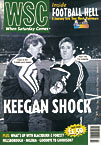 Mark Wenham looks at the causes of the riot at a Bristol derby match
Mark Wenham looks at the causes of the riot at a Bristol derby match
The events of December 15th may have caused eyebrows to be raised nationally, but for anyone who has regularly attended Bristol football derbies over the last ten years, the whole day had a grindingly predictable feel to it.
City had, as usual, been installed as favourites by the bookmakers and the local soccer pundits. Crowd trouble, another feature of recent games between City and Rovers, was also anticipated by many supporters, to the extent that 1,500 of Rovers’ ticket allocation still hadn’t been sold up to the Friday before the match. Add to this a fifteen minute wait to get served in our normal, genteel pre-match boozer, arguments in the Dolman Stand with the once-a-year punters over seat ticket numbers, and the presence of the dreaded Bristol Samba Band stalking the touchlines with their instruments of torture, and it was clear to me that it was going to be one of those days.
As we entered injury time, with City leading 1-0, three-quarters of the stadium rose to celebrate a hard earned win. At which point, obviously, Rovers scored. The subsequent violence, in which 300 City supporters broke through a line of police and stewards, and tried to attack Rovers fans situated in the East End of the ground, has been well documented nationally, as have the attempts of a smaller mob of fans to assault Rovers players after the game.
The aftermath of a football crisis rarely lends itself to deep thought or wise counsel, and, as the officials of both Bristol clubs grieved for reputations torn asunder, they proclaimed their belief that this was an incident that could not have been avoided. There had been powers at work beyond the ken of committee men and the local forces of law and order. It was official: the Seventies style football hooligan was back.
Scott Davidson, Chairman of Bristol City, started the ball rolling. “These weren’t our real fans, but thugs on a day out to cause trouble.” These views were echoed by his opposite number at Bristol Rovers, and had soon been adopted by the local press as their version of the truth. “These were not the City supporters I mingle with every other Saturday.”said Tim Davey, Evening Post correspondent and self styled voice of the fans.
David Shattock, Chief Constable of Avon and Somerset, and those in charge of the police operation on the day, declared that they were satisfied that 150 officers on duty had been sufficient for this fixture, but, in their opinion, pre-planned hooliganism on this scale was impossible to police. All of which has made for an open and shut case, with no difficult questions left unanswered, and assurances from all concerned that once the perpetrators of the violence had been identified by video and banned for life, the crowd trouble at City versus Rovers games would start to die away. The result of which, surprise, surprise, is that an opportunity for everyone involved with Bristol football to take stock and absorb the lessons of December 15th, may have been lost amidst the noise of feet being dragged and blame being shifted elsewhere.
The responsibilities for the events that day don’t begin and end with the 300 people that invaded the pitch. Ian Holloway, the Bristol Rovers manager, was the first person to acknowledge that factors other than hooliganism may have been involved, when he questioned the role of the local press (i.e. the Evening Post), in the way that it had hyped up this fixture. The emotive, at times apocalyptic (“Seven Days To Go!”) use of language, culminating in an eight page pull out on the Saturday before the game, left readers in no doubt that this was, “the biggest showdown in years.”
All of which, it seems, was news to the police. Despite an identical attempt to attack the Rovers end in the corresponding fixture last year, a relatively small number of people were still able to wreak havoc. Little wonder that many Rovers fans feel they did not receive the police protection that a game of this nature demanded. Finally, and most uncomfortably, the violence asks questions of a substantial minority of City supporters, myself included, for whom this particular fixture has become too important. Down here in the West Country a lack of footballing success and our geographical distance from any other rivals has created a goldfish bowl effect, in which our results in relation to each other have assumed too great an importance. Expectations for a City fan – heightened by a ‘Sleeping Giant’ complex, a top class stadium and a string of big name managers – are routinely dashed, the presence of Rovers in the same division, and their defeats of our team, a mirror to our own frailties.
This has created a situation in which a healthy metropolitan rivalry has, for many of us, been replaced by something akin to hatred. The songs we sing,the chants we make, and the overwhelming importance we attach to our games against ‘The Gas’ has meant that for some people violence against Rovers fans was less an abhorrence, more a logical progression. The events of December 15th should serve as a lesson for us all here in Bristol. The media, the police, and the fans all helped to create the context in which Rovers fans were attacked. It’s not just the hooligans who need to mend their ways. All together now, “Two teams in Bristol…"
From WSC 120 February 1997. What was happening this month